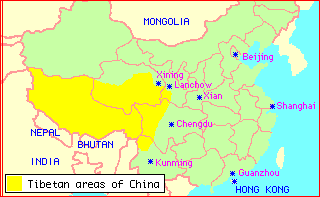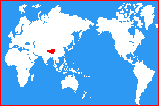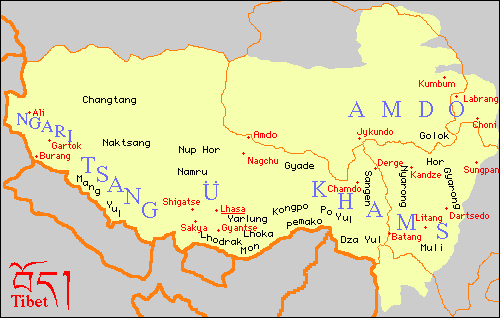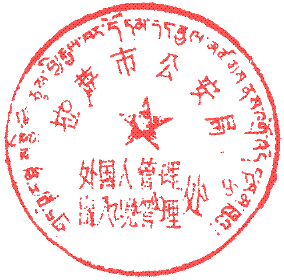
Tibet and the surrounding regions (6 Kb)
 The World-Wide Web Virtual Library
The World-Wide Web Virtual Library
|
|---|
See also TIBET The Internet Travel Guide (www-students.unisg.ch,Switzerland)

The advice about travel regulations applies mainly to non-chinese. If you are a ROC citizen or HK citizen ("Overseas Chinese") travel will be easier. If you are a PRC citizen, I m sure you can tell me more about it than I can tell you (please email me, I'd be interested to include this information too).
Tibet is always put forward as the stereotypical "remotest place in the world", but travel to Tibet is not so much of a problem as you may think. Parts of Tibet are open to individual travellers, so if you have a bit of spare cash you could be there in thirty or forty hours (or sooner if you live in a nearby region).


Tibet and the surrounding regions (6 Kb)

Regions and Towns in Tibet (9 Kb)
Tibet is a culturally, religiously, ethnically, linguistically and geographically distinct region located to the north of India. The only aspect which isn't distinct is the one that counts for most these days: the political aspect. Immediately prior to 1951 Tibet was a defacto independent country with its own governmental, political and judicial systems. For centuries Tibet had remained stubbornly isolated and aloof from the rest of the world, partly through its own volition and partly due to Chinese encouragement. However its independent status, though self-declared, was never recognised by any outside party. China has made consistent territorial claims over Tibet and has in the past exerted varying degrees of political control. Since 1951 Tibet has been fully incorporated into the Peoples Republic of China.
For the purposes of this document and travel in general, Tibet is an area inside the borders of the Peoples Republic of China which is inhabited by Tibetan people. There are several other "Tibets" refered to by various people:
The climate:
Winter is cold, but with little snow (except in the Yadong / Chumbii
Valley area). The sun still shines brightly, and keeps things bearable, but the air
is cold. In Lhasa I have been sunburned in December, while on the shady
side of the street the gutters are full of ice as late as March.
Summers are warm, but not really hot, though the sun can be very strong
due to the altitude.
In central and Western Tibet there is a mini monsoon in June, though
little rain crosses the Himalayas. In the regions at the edge of the
Tibetan Plateau (Eastern Amdo and Khams) the rain is not so predictable
(apparantly the summer and autumn are dryer times of year).
Trekking in mid-winter is not really feasable due to the cold and the
shorter days: The daytime temperature can be as low as -40C (that's -40F);
the sun doesn't rise till past 09:00 (or later if you are in the
shaddow of a large mountain) and gets dark by 17:30. (I know - I've tried
it)
Certain times of year are politically sensitive:
At these times both individual and group travel may well be restricted. Flights to Lhasa may be "fully-booked" and in some years individuals have been cleared out of Lhasa. It all depends on the prevailing political situation. If the authorities are feeling confident they may not mind your presence.
These patterns in the political climate are unique to Lhasa (and the routes leading to it). You will not feel their effects in other places, although travel in Central Tibet can be affected because the road to many places goes through Lhasa.
There are special regulations posted in all Lhasa Hotels forbidding people from joining in protests and demonstrations, or even watching them. You can be sure that the police will ensure you adhere to these regulations, to stop you doing a bit of ad hoc journalism (journalists are not allowed in Tibet).
As a tourist you are very very unlikely to be endangered if there should be a demonstration. The chinese officials would not want to upset their tourist guests, lest they go home speaking ill of the situation. The tibetans will not want to harm their most important witnesses: as foreign journalists are not allowed in Tibet, there will be no-one else to bear witness.
The first point is something which you must decide for yourself, but I feel that this worry is outweighed by the personal insight one can gain into the current political situation. It must also be borne in mind that over 98 percent of Tibetans live (willingly or otherwise) under the jurisdiction of the Peoples Republic of China and one cannot ignore them; they are trying just as hard to free their country as those in exile. Some live within the system, trying to get the best for themselves and their culture, whereas others attempt to live inspite of it, ignoring the rules.
It is true that Tourism in Tibet is used as a propaganda weapon by Beijing to purvey the message that all is calm in Tibet. If this irks you (as it does me) then make sure you tell people how it really was when you get back home.
The second point is something in my view is far more serious:
Many shops and restaurants are not owned by Tibetans, but by migrants. These migrants are encouraged by tax breaks and other government measures. The government would appear to be following a policy of cultural harmonisation by marginalising Tibetans and Tibeatan culture through a dilution of the Tibetan population. This is being done in the hope that future Tibetans will not be able to differentiate themselves from people in other parts of China. This policy would appear to have had some success in Chinese Inner Mongolia where Mongolians are outnumbered 20:1.
As tourism is an important part of the local economy, the growth of tourism will allow more migrants to earn a living in Tibet. There are two ways to combat this: don't go to Tibet, or if you do choose to visit, then you should stay in Tibetan owned hotels, shop in Tibetan stores and eat in Tibetan restaurants. Anyway, who wants to go all the way to Tibet just to eat cuisine from China? The Chinese and Hui food is far better in Chengdu and Linxia.
Tibetans can get 20 years in prison for this. It is a counter revolutionary crime. For example Yulu Dawa Tenzin was jailed for 20 years specifically for talking of independence with a foreign tourist. Even if people do want to talk, this may be due to a misplaced idea that you are a journalist or similar. Be sensitive to this.
There was a story a few years ago: Someone in India encouraged people to go to Tibet and "collect evidence" Acting on this, a tourist tried to record an interview with a nun in a muslim-owned tea-house opposite the Snowlands Hotel. The ever present police-spy called his masters and a police raid was staged. The poor nun was dragged away to [I assume] imprisonment and torture. The tape recorder was snatched for evidence and the feckless tourist was left to ponder on it all, free to go home...but doubtless unable to sleep at night.
Inspite of stories such as the one above, some people are alarmingly eager to tell you of their plight. In doing so they are taking a great risk, but are also putting a certain burden onto the listener: It might be flattering to have someone risk torture just to talk to you, and it might make a good adventure story for the folks back home, but the person is telling you all this in the hope that you will actually do something. The subleties of the political situation can be hard to grasp. Ask yourself what is really going on. On the surface, things look almost normal. Life goes on. It is not easy if you don't speak so much Tibetan. Before you go, read up on Tibet, its history and politics. This is far better than reading it when you get back, wondering what it was all about. See the reading list
Responsible Travel:
In towns and villages all over there are temples, monasteries and convents being rebuilt. But in Lhasa the big monasteries of Sera, Drepung and Ganden are tightly controlled by Government authorities and therefore a bit lifeless.
What have't been rebuilt are the fortresses and the mountain-top monasteries the ruins of which you will see again and again on the road between Lhasa and Nepal.
The main disadvantage of group travel is that you may end up with an un-balanced view of the political situation: Tour guides can feed their clients with information reflecting the party line on historical and political issues, such as blaming all the destruction on the British invasion of 1904. (yes-they did destroy a little bit, but not all...)
One client I met was in the middle of Lhasa with his guide, when out of nowhere a group of nuns appeared waving flags and shouting. Not realising what was going on the gentleman asked his guide, and was told that the nuns were taking part in a religeous ceremony. He was then ushered away (before the police arrived).
Such stories tend to emanate from clients of Chinese Government owned Tour Companies, or western companies using CITS Chinese guides.
The Beijing Officials:
These people say things like "Of course tourism is allowed in Tibet, there
are no restrictions on travel; why should there be? there are no problems
in Tibet. Tibet is politically stable..." etc.
However, these people have no control on the ground.
The City Police and government officials:
These people want tourism in Lhasa to develop the local economy, and so
they want you.
Times were hard in Lhasa after martial law was imposed and all tourism
was stopped, and they do not want a repeat of that.
They are responsible for you when you are in Lhasa.
The Army and Armed police:
The Army and Armed police (wu jin) are charged with the job of
preventing civil disorder in Tibet and Lhasa in particular.
They note that some tourists tend to support the Tibetans and their
political aspirations, and they suspect tourists of agitating local
Tibetans and of smuggling in pro-independence propaganda.
Tourists have also been caught photographing and filming demonstrations
for publication abroad etc etc.
The Army has little interest in promoting tourism (although it is
probably owns a few hotels etc) and no interest whatsoever in promoting
individual travel.
The army controls the checkpoints on the roads to Lhasa, at the border
with Nepal, and in the airport.
So, what does this all mean?
If things are calm, then you will be able to buy your bus/plane ticket
and go to Lhasa. No problems.
If things are not so politically quiet, then they won't sell you the
tickets or give you a permit. If, however inspite of this, you still manage
to get to Lhasa (by escaping from a group tour or sneaking past the
checkpoints) then you will be tollerated in Lhasa once you arrive.
I recall people being caught at the checkpoint at Toellung Dechen (10km
W of Lhasa) and being sent back to Golmud, whilst myself and a dozen others
were staying in Lhasa hotels unhindered by the local police.
You can join a small tour that will get you a 10 day visa and transport to Lhasa. You should consider getting a visa lasting longer than the tour if you wish to stay on. These should be available through your tour organiser, for an extra fee. (See How do I get a Visa for individual travel) After you reach Lhasa the tour ends and you are free to do what you want. The cost is about USD250 I think. (You can probably extend your visa once in Tibet).
NB this idea of letting Individual travellers across the border is NOT the norm, and it may well change. Then you'll have to take the small tour.
Fly to Lhasa from Chengdu:
If you are lucky you will be sold a ticket by the local Airline office.
They may refer you to the police station where you must ask for a
permit; This will be issued (or not) at their discretion.
Once you have the ticket, you may yet be asked for a permit at the
airport Check-In desk, which is OK if you have one already.
Confused? Well try your luck. People regularly do reach Lhasa this way,
but at certain times they restrict travel to Lhasa.
When people can fly in from Chengdu, Lhasa quickly fills up with
tourists. Something that the authorities wish to avoid if they think there
may be political unrest.
Take the bus from Golmud:
At the Lhasa bus station in golmud they have now built a CITS office to
sell bus tickets to foreigners.
The price is RMB950. This is somewhat irksome as the locals only have
to pay RMB100. If you are "Overseas Chinese" then you could try and save
yourself some money here.
The only time they were not selling people tickets to Lhasa from here
was during Martial Law (June 1989- May1990); which makes this the most
reliable entry point to Lhasa.
There are some independent busses going to Lhasa which are cheaper, but
you may well be caught at the police check- points, and sent back to Golmud
(without a refund).
Back to the top
Permits are issued to a limited number of places and they wont tell you
which ones; You just have to ask.
Permits have been issued to Burrang and Mt Kailas, to Kongpo, for
travel overland Lhasa-Chengdu and no doubt many other places.
At the same time many people get nothing...
Below is a list of interesting Tibetan-inhabited places that are worth a visit. Most are open with no permit, others require a permit, but they are happy to issue it to you. It is not difinitive, as things change all the time. If in doubt ... Ask.
Qinghai Province:
-Regong (chinese name Tongren) Open without permit.
A bit politically a bit sensitive due to independence demonstrations
held here a few years ago.
The town is not so special with many Chinese residents, but the
surrounding countryside is very much Tibetan.
The last Tulku of Regong was killed in the 1950s when the whole region
was in revolt. The main monastery was destroyed but is now in the process
of being rebuilt.
-Kumbum (chinese name Taer-su or Hongyuan) Open without permit.
Only a few kilometres from Xining this important monastery is on the
borders of ethnic Tibet. In the summer it is full of local tourists
demonstrating their lack of respect towards Tibetan Culture. In the winter
there are far more Tibetan Pilgrims.
In 1988 there were demonstrations here in support of those in Lhasa.
The participants were arrested.
Most other parts of Qinghai are still closed to individual travellers.
Get caught in the towns and the local PSB will arrest you. This is not
so serious as it might seem, but it does put take a bit of the inertia out
of your trip.
Out in the countryside there are no PSB, but they do live in the villages.
Gansu Province:
-Labrang Trashikil: (Chinese name Xiahe) Open without permit.
This Important monastery might look impressive, but if you compare it
with the photo in "The Anye-Ma-Chhen Range and Adjacent Regions" by J F
Rock (1956) you will see that half of it has been destroyed.
Still, plenty too see. Get yourself into the surrounding countryside too.
Read an account of the destruction and looting of the monastery in "Tibet
behind the Ice Curtain" by Vanya Kewley. pp 314-319
-There are other places open between Labrang and Zoige which is in
Sichuan province, you can travel this road (with a permit), but don't just
do it in the bus - stop, get off and explore!
Sichuan Province:
-Kanding: (Tib. Dartsedo) Open without permit.
Called Tasienlu in some books. This is the old border of Tibet. There's
not too much Tibetan culture to see here now.
There used to be a huge Catholic cathedral, but not any more!
-Ganze: Open without permit (I think).
More Tibetan than Kanding. the road between the two is also interesting.
-Aba: This place is hard to get to (only by permit, and you
cant have one!)
There have been some disturbances here too.
Lots of Tibetan culture here, so I'm told. The Monastery in Aba, Kidje
Gompa (spelling??) has two thousand monks, making it the largest in all
Tibet.
(I think this bit's true, but would stand corrected??)
-Litang (no info)
-Batang (no Info)
-Zoige: Open with permit.
Pretty lifeless, but in a wonderful ocation in the middle of the plains.
If you are there during one of the festivals then you would have some
real fun.
-Sungpan: Open without permit.
This is a chinese town in Tibetan countryside. The monasteries are all
up in the hills. Good for exploration.
Yunnan Province:
(no Info)
Tibet Autonomous Region:
-LhasaOfficially open without permit.
Lhasa and the road to Nepal and Golmud are officially open to
individuals. This may change and does not imply that you will be alowed to
travel there.
(see getting to Lhasa section above.
-Shigatse Openpen without permit.
If Lhasa is open Shigatse will be too.
-Other places may or may not be open. Ask for a permit at your friendly local PSB.
I have only mentioned the towns.
The countryside is far more obviously Tibetan than the towns, which are
usually modern built with concrete appartment blocks.
They suffered most in the liberation and the cultural revolution.
It involves a bit more effort to travel in the countryside, but is far
more rewarding.
Other places to get a visa:
Hong Kong
If you want a 90 day visa then Hong Kong seems to be the best place.
There are numerous travel agents who offer to get you one, but its cheaper
to do it yourself at the Chinese pseudo-Embassy. (They can't call it an
embassy as China does not recognise HK as foreign territory, so it's called
some stupid name that I've forgotten)
Kathmandu
In Kathmandu they are not so generous.
At the time of writing they are still not issuing visas in
Kathmandu, (but people who have got their visas from elsewhere can cross
the border into Tibet)
You cannot get a visa without joining a group tour, but you can join
the group IN Kathmandu and a "group" can be one person.
You can probably get a visa lasting longer than the tour, for an extra
fee. Ask your tour organiser.
Nevertheless, you will only get a visa valid for 20 days or so. If you
are planning a longer trip, then HK is still the best place.
Delhi, Bangkok, Manila, Singapore, Jakarta, Kuala Lumpar... Sorry I have no concrete information, but I believe that they will issue you with a 30day Visa, no worries.
Tokyo
When I was in Tokyo, which is a while ago now, They were only issuing short
Visas to Japanese passports holders (for a very hefty fee indeed) but
holders of other passports got three month Visas for little cost.
Extending the Visa once in China and Tibet
At present you can buy 15 day visa extensions in Tibet (25FEC). (you
may well be able to get a 30 day extension)
You will be able do do this a maximum of two times only.
This seems to be the standard throughout PRC at present.
Visa extensions are ultimately issued at the discression of the local
PSB (police) and cannot therefore be 100 percent relied upon. Things change
fast. Around plitically sensitive anniversaries they may stop issuing
extensions.

(shown here is the stamp of Lhasa PSB (6 Kb))
If you can persuade the policeman or policewoman to issue you the permit, then you are lucky. It will probably cost you a few Renminbi.
Permits are issued to a limited number of places and they won't tell you which ones; You just have to ask. Permits have been issued to Mt Kailas, to Kongpo, for travel overland Lhasa-Chengdu and no doubt many other places.
At the same time many people get nothing... you will just have to try your luck.
Those amongst us who insist on going to closed places with no permit or overstaying their visas will get into trouble with the PSB. They are wiser than they were a few years ago and not as lenient.
Fines can be quite large.
If the place is not a tourist town, then they will not be equipped to
deal with you. There is a special book containing laws for dealing with
foreigners; A5 size with a blue cover and if the police don't have one,
they just want rid of you, so you'll get escorted onto the next bus or
truck out.
If you're unlucky they'll send you to some police who do know how to
deal with you. That's when you get fined and/or sent home.
This is the paranoid totalitarian state in action. These people are charged with the job of keeping tabs on the foreigners and the locals too; the furtive spies will rush back to file their report on what you were saying...
They are nothing to worry about, just a distraction from the sightseeing.
NOTICELadies and Gentleman Welcome to Lhasa. So that you may have a safe and enjoyable travels, we would like you to be aware of the following government regulations:
1) Foreigners travelling in China must abide by Chinese law and must not endanger the national security of China, harm its Public interests, disturb the Public order, or engage in any other acticvities incompatible with tourists status.
2) If Chinese citizens are holding a rally or demonstration, it is strictly forbideden for foreigners to participation, follow along with, take pictures or video film any of these affairs. Foreigners are not allowed to interfere in Chinese internal affairs.
3) Foreigners are forbidden to distribute any propaganda material and join in any religious activity.
4) In accordance with regulations, foreigner tourists must go through all registration formalities and stay only at a designated hotel. Without prior permission it is forbidden to travel in unopened areas, to use undesignated transportation, to operate individual business or privately take up an occupation.
5) It's forbidden to visit and photograph the sky burial site according to the local government's regulations for the minority nationality's habits and customs. The tourist who breaks the regulation will be punished strictly.
6) For safety reasons, it is strictly forbidden for foreign tourists to travel by tractor or other privately operated means of transport. If by any hance a traffic accident happens, under these circumstances you will be responsible for your own actions and the results.
7) Valuables should deposit in checkroom, otherwise, the hotel won't be responsible for the loss.
Bureau of Foreign Affairs & Tourism of Lhasa [with stamp in Chinese and Tibetan]
Travel Bureau of ChendGuan District
Division of Aliens and Exit-Entry [with stamp in Chinese and Tibetan]
Admistration Lhasa P.S.B [with stamp in Chinese and Tibetan]
June 17 1994
Get one with Tibetan script written in it, that way even if you can't pronounce the phonetics you can point at the words and people will understand.
Any updated information, corrections or comments would be appreciated.
Mail me at: andrew@dorje.demon.co.uk
Disclaimer: The information included in this document is offered in good faith, however the author bears no responsibility for any inaccuracies contained herein or for any situations arising from your interpretation of this document. This document and the pictures it contains are (c) Copyright 1995, but I'll let you copy it as long as you don't try and sell it or include it in a publication for which you then ask money.